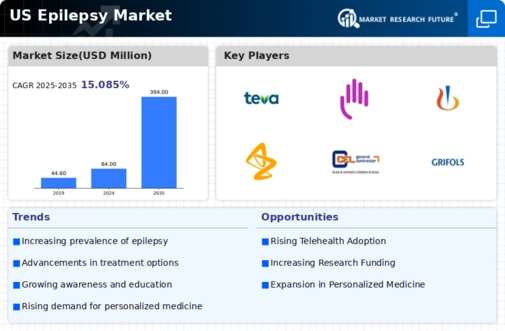Innovative Drug Development
The epilepsy market is significantly influenced by the ongoing innovation in drug development. Pharmaceutical companies are increasingly investing in research and development to create novel antiepileptic medications. The introduction of new drugs, such as cannabidiol (CBD) oil, has shown promise in treating certain types of epilepsy, particularly in pediatric patients. The market for these innovative treatments is projected to grow, with estimates indicating a potential increase of over 20 % in the next five years. This surge is driven by the need for more effective therapies that offer fewer side effects compared to traditional medications. Additionally, the approval of new drugs by regulatory bodies enhances the treatment landscape, thereby expanding the epilepsy market. As a result, patients and healthcare providers are likely to have access to a broader range of therapeutic options.
Rising Incidence of Epilepsy
The increasing incidence of epilepsy in the US is a crucial driver for the epilepsy market. Recent estimates suggest that approximately 3.4 million people in the US are living with epilepsy, which translates to about 1.2 % of the population. This growing prevalence necessitates enhanced treatment options and healthcare services, thereby propelling market growth. The rising number of diagnosed cases is likely to stimulate demand for antiepileptic drugs and other therapeutic interventions. Furthermore, the aging population, which is more susceptible to neurological disorders, contributes to this trend. As the population ages, the incidence of epilepsy is expected to rise, further impacting the epilepsy market. This demographic shift indicates a sustained need for innovative solutions and comprehensive care strategies in the epilepsy market.
Enhanced Diagnostic Techniques
Advancements in diagnostic techniques are playing a pivotal role in shaping the epilepsy market. Improved imaging technologies, such as MRI and EEG, enable more accurate and timely diagnosis of epilepsy, which is essential for effective treatment. The ability to identify specific types of seizures and their underlying causes allows for tailored therapeutic approaches. This trend is likely to increase the number of patients diagnosed and treated, thereby expanding the market. Furthermore, the integration of artificial intelligence in diagnostic processes is expected to enhance the efficiency and accuracy of epilepsy diagnosis. As these technologies become more widely adopted, the epilepsy market may experience a notable increase in demand for diagnostic services and related products, ultimately benefiting patients and healthcare providers alike.
Government Initiatives and Funding
Government initiatives and funding aimed at epilepsy research and treatment are crucial drivers of the epilepsy market. Federal and state programs are increasingly allocating resources to support epilepsy research, public awareness campaigns, and access to care. For instance, the National Institutes of Health (NIH) has dedicated substantial funding to epilepsy research, which fosters innovation and the development of new therapies. Such initiatives not only enhance the understanding of epilepsy but also improve treatment options available to patients. Furthermore, policies aimed at increasing access to care for individuals with epilepsy can lead to higher demand for medical services and products. As government support continues to grow, the epilepsy market is likely to benefit from increased investment in research, education, and healthcare services.
Growing Patient Advocacy and Support Groups
The rise of patient advocacy and support groups is a significant driver in the epilepsy market. These organizations play a vital role in raising awareness about epilepsy, educating the public, and advocating for better treatment options and policies. Their efforts contribute to a more informed patient population, which can lead to increased demand for healthcare services and medications. In recent years, the number of advocacy groups has surged, providing resources and support for individuals living with epilepsy. This growing network of support is likely to empower patients to seek treatment and engage with healthcare providers, thereby positively impacting the epilepsy market. Additionally, these groups often collaborate with pharmaceutical companies and researchers to promote clinical trials and new therapies, further driving market growth.
























Leave a Comment